#fossil foliage
Explore tagged Tumblr posts
Photo

Alethopteris Fossil Leaf Fern – Carboniferous Coal Measures – Radstock, Somerset, UK – Authentic Plant Fossil
Authentic Alethopteris Fossil Leaf Fern – Carboniferous Coal Measures – Radstock, Somerset, UK
This listing features a beautifully preserved fossilised leaf of Alethopteris, a type of seed fern (Pteridospermatophyta) common in Carboniferous coal swamps. This specimen was excavated from the historic Coal Measures strata in Radstock, Somerset, and dates to the Late Carboniferous Period (Pennsylvanian Subsystem), approximately 310 million years ago.
Geological & Palaeobotanical Details:
Fossil Genus: Alethopteris
Family: Alethopteridaceae
Order: Medullosales
Class: Pteridospermatophyta (Seed Ferns)
Geological Age: Carboniferous (Pennsylvanian)
Formation: British Upper Coal Measures
Depositional Environment: Moist, equatorial deltaic swamp with fluctuating water levels – a habitat ideal for dense vegetation and coal formation
Location: Radstock Coalfield, Somerset, United Kingdom
Morphological Features:
Distinctive bipinnate fronds with symmetrical leaflets (pinnae)
Prominent midribs and lateral venation typical of seed ferns
Leaves believed to belong to seed-bearing plants, now extinct
Biozone (if assigned): Typically associated with Lenisulcata or Gastrioceras ammonoid zones regionally
Fossil Identification: Described and classified in the 19th century; remains a key taxon in palaeobotany due to its prevalence and role in coal formation
Specimen Notes:
Discovered by: UKGE team members Alister and Alison
Discovery Date: 06 March 2025
Preparation: Cleaned, stabilised, and prepped by Alison
Condition: Well-defined fossil on natural matrix, showing clear detail of fossilised leaf structure
Photography: Scale cube = 1cm. Photos show actual specimen – what you see is what you will receive
Authenticity: Comes with Certificate of Authenticity – all fossils sold by us are genuine and responsibly sourced
Why Choose Alethopteris?
Alethopteris is not only a stunning example of Carboniferous flora but also a tangible link to the lush tropical landscapes that once dominated Europe. Its role in forming the vast coal beds of the UK makes it both a beautiful and historically significant specimen for collectors, educators, or as a natural history display.
Secure a genuine piece of Earth’s botanical past today with this expertly sourced and prepared fossil fern.
#Alethopteris fossil#fossil fern#Carboniferous plant fossil#Coal Measures#Radstock fossil#Somerset fossil#UK fossil plant#genuine fern fossil#Alethopterid leaf#palaeobotany#fossil foliage#Pennsylvanian fossil#authentic fossil leaf#seed fern fossil
0 notes
Text

Duonychus tsogtbaatari was a therizinosaurid dinosaur living in what is now the Gobi Desert in southern Mongolia during the Late Cretaceous, around 96-90 million years ago.
Like other therizinosaurids it would have been a chunky-bodied herbivore with a small beaked head atop a long neck, long rake-like claws on its hands, stout legs, and a rather short tail. But it was rather small compared to most of its close relatives, estimated at about 3m long (~9'10"), with its known fossil remains including several vertebrae, partial ribs and pelvis, and a set of nearly-complete arms and hands.
Its hands had only two well-developed fingers, with a small splint-like vestigial third finger, an anatomical condition convergently seen in some other theropod groups but previously unknown in therizinosaurids. One of its long curved claws also preserved a rare example of a thick keratinous sheath, showing that in life the claw was over 40% longer than its bony core.
Duonychus' elbow and finger joints had a fairly limited range of motion – more similar to the forearms of Tyrannosaurus than other therizinosaurids – but its claws were able to flex almost 90° at the tips of its fingers, which may have given it the ability to reach out and grab onto foliage with a very strong and precise grip.
———
NixIllustration.com | Tumblr | Patreon
References:
Kobayashi, Yoshitsugu, et al. "Didactyl therizinosaur with a preserved keratinous claw from the Late Cretaceous of Mongolia." iScience 28.4 (2025). https://doi.org/10.1016%2Fj.isci.2025.112141
Wikipedia contributors. “Duonychus” Wikipedia, 18 May. 2025, https://en.wikipedia.org/wiki/Duonychus
Woodford, James. "Two-fingered dinosaur used its enormous claws to eat leaves" NewScientist, 20 Mar. 2025, https://www.newscientist.com/article/2473027-two-fingered-dinosaur-used-its-enormous-claws-to-eat-leaves/
#science illustration#paleontology#paleoart#palaeoblr#duonychus#therizinosauridae#therizinosauria#manraptora#theropod#dinosaur#art#turkeysloth
246 notes
·
View notes
Text


What did dinosaurs sound like?
We tend to associate dinosaurs with ground-shaking roars, but the latest research shows that this is probably mistaken.
You'd feel it more than hear it – a deep, visceral throb, emerging from somewhere beyond the thick foliage. Like the rumble of a foghorn, it would thrum in your ribcage and bristle the hairs on your neck. In the dense forests of the Cretaceous period, it would have been terrifying. We have few clues for what noises dinosaurs might have made while they ruled the Earth before being killed off 66 million years ago. The remarkable stony remains uncovered by palaeontologists offer evidence of the physical prowess of these creatures, but not a great deal about how they interacted and communicated. Sound doesn't fossilise, of course. From what we know about animal behaviour, however, dinosaurs were almost certainly not silent. Now with the help of new, rare fossils and advanced analysis techniques, scientists are starting to piece together some of the clues about how dinosaurs might have sounded...
Read more: https://www.bbc.com/future/article/20221212-the-mysterious-song-of-the-dinosaurs
277 notes
·
View notes
Text
more words for worldbuilding (pt. 2)
ANIMALS
Animal: adult, beast, buck, cat, chicken, cur, father, frog, goat, half-breed, horse, hybrid, litter, mongrel, monster, parasite, pig, stock, young
Bird: bird, chicken
Fish: aquarium, aquatic
Group of animals: drove, herd, insect, pack, stock, team
Insect: bee, grub, pest
Limb or appendage of: bill, coat, feather, fur, mop, pelt, scale, trunk, wing
Mammal: cat, dog, father, goat, hound, mother, pig
CLOTHING
Accessory: bag, belt, buckle, collar, pocketbook, purse, satchel
Clothing: apparel, array, bathing suit, cape, clothes/clothing, costume, dress, dungarees, falsies, frock, garment, girdle, gown, hat, jacket, negligee, nylons, pajamas, pants, quilt, scarf, skirt, suit, swimsuit, thing/things, trappings, underwear, veil, wash, wrap
Part: collar, crown, pocket, strand, tiara
State of dress: bareness, nudity, try on/try out, wear
FOOD & DRINK
Beverage: alcohol, coffee, drink, potable
Beverage, alcoholic: beer, liquor
Change in: curdle, turn
Food: appetizer, bite, brew, bun, casserole, condiment, cracker, diet, doughnut, feed, frosting, grub, helping, hors d’oeuvre, leftover, macaroni, meat, nosh, nurture, nutrition, pastry, produce, refreshment, seasoning, stew, subsistence, support, sweet, treat, vittles
Food part: morsel, nip, taste, tidbit
Meal: banquet, bite, buffet, diet, fare, picnic, repast, spread, table
Produced from animal: comfort food, feed, food, frosting, grub, hero, macaroni, sandwich, submarine, vittles
Produced from plant: condiment, doughnut, loaf, pastry, produce, sweet
Quality of: acerbity, baked, done, edible, mellow, nourishing, perishable, rare, ripe, salty, short, stale, strong, sweet, unappetizing, weak, wholesome
NATURAL RESOURCES
Electricity: beam, spark
Energy: electricity, fuel, nuclear energy, petroleum, power
Expression of energy: blast, bonfire, chill, concussion, discharge, fire, flash, noise, thunder
Natural event: eclipse, meteorology, weather
Resources: fuel, resource, rock, substance
PLANTS
Flower: bloom, bouquet, flower
Fruit: berry, produce
Growth or death of: bloom, bud, germinate, growth, wilt, wither
Part: bark, branch, cereal, flavoring, foliage, grain, juice, limb, nut, pod, scion, shell, stalk, trunk
Plant: algae, bramble, bush, crop, fossil, grass, harvest, hybrid, organism, produce, wreath
Tree: timber, wood/woods
Vegetable: produce
WEATHER
Object connected with: avalanche, breeze, climate, cold, dew, film, flurry, frost, gust, haze, hurricane, meteorology, moisture, puff, thunder, weather, wind
Quality of: breezy, clear, close, crisp, dismal, fair, fiercely, fine, furious, gloomy, hazy, humid, intimidating, misty, oppressive, raw, rugged, soft, stormy, sultry, temperate, thick, tranquil, turbulent, wild, wintry
Type of: blizzard, cloud, drizzle, fog, hail, mist, puff, rain, shower, tempest, torrent, tremor
NOTE
Excerpted from Roget's 21st Century Thesaurus, Updated and Expanded 3rd Edition, in Dictionary Form, edited by The Princeton Language Institute.
The above are concepts classified according to subject and usage. It not only helps writers and thinkers to organize their ideas but leads them from those very ideas to the words that can best express them.
It was, in part, created to turn an idea into a specific word. By linking together the main entries that share similar concepts, the index makes possible creative semantic connections between words in our language, stimulating thought and broadening vocabulary. Writing Resources PDFs
Source ⚜ Writing Basics & Refreshers ⚜ On Vocabulary
#worldbuilding#vocabulary#langblr#writeblr#writing reference#spilled ink#creative writing#dark academia#setting#writers on tumblr#poets on tumblr#poetry#literature#writing tips#writing prompt#writing#words#lit#studyblr#fiction#light academia#nature#food#writing resources
471 notes
·
View notes
Text




A Victorian library with lush foliage, big open windows + newly discovered fossils 🌿🦴🪴
Ma'am, there's no candy allowed in here

#animal crossing#acnh#ac#animal crossing new horizons#animal crossing community#new horizons#hhp#happy home paradise#animal crossing interior#solaire🌞
248 notes
·
View notes
Text
Round 3 - Actinopterygii - Osteoglossiformes
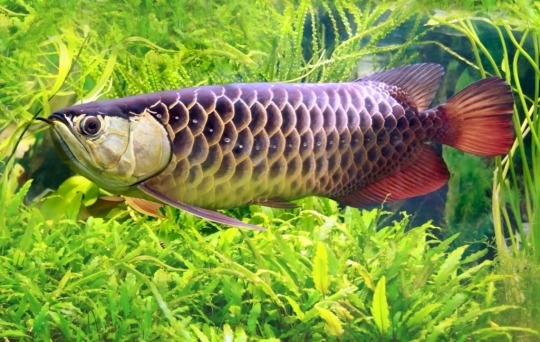
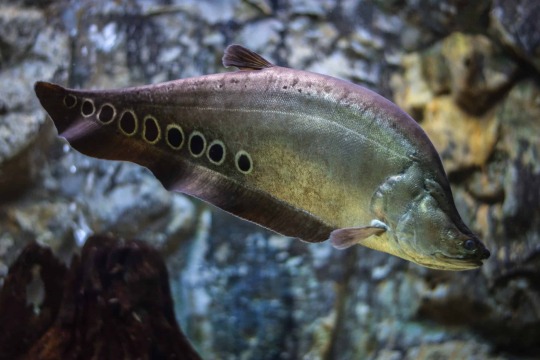


(Sources - 1, 2, 3, 4)
Order: Osteoglossiformes
Common Name: no common name for the whole order
Families: 6 - Pantodontidae (“Freshwater Butterflyfish”), Osteoglossidae (“bonytongues” and “arowanas”), Arapaimidae (“arapaimas”), Notopteridae (“featherback knifefishes”), Gymnarchidae (“African Knifefish”), and Mormyridae (freshwater elephantfish”)
Anatomy: elongated body; toothed or bony tongues; long or absent dorsal and anal fins positioned near the caudal fin; large swim bladder enables them to breathe at the surface of the water; most are adapted for surface feeding
Diet: arthropods, fish, snails, frogs, lizards, snakes, mice, bats, and small birds
Habitat/Range: slightly acidic freshwater in South America, Africa, Australia, and Southern Asia
Evolved in: Late Jurassic
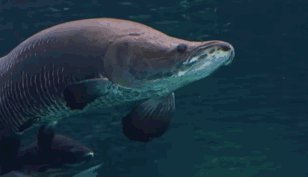
(source)
Propaganda under the cut:
Freshwater Butterflyfish (Pantodon buchholzi) (image 4) have very large pectoral fins. If enough speed is built up underwater, a butterflyfish can jump and glide a small distance above the surface to escape predators. It wiggles its pectoral fins as it glides, with the help of specialized, enlarged pectoral muscles.
Arowanas (genus Osteoglossum) can jump up to 2 m (6.6 ft) out of the water to pick their prey off of branches, tree trunks or foliage, which has earned them the local name "water monkeys". They are the largest fish in the world to catch most of their food out of water.
Male arowanas brood their young within their mouth, only fully releasing them when they are about 7 cm (2.8 in) long.
The endangered Asian Arowana (Scleropages formosus) (image 1) is also known as the “dragonfish”, due to its large metallic scales and long barbels giving it a resemblance to the Chinese dragon. The popularity of this beautiful, auspicious fish has had both positive and negative effects on their status as endangered species, as they are in high demand in the home aquarium trade. Legal pet Asian Arowanas must be bred in captivity on a fish farm for at least two generations, have a certificate of authenticity and a birth certificate, and an implanted microchip to identify the individual. There are over 150 CITES-registered Asian Arowana farms in Singapore, Malaysia, Indonesia, and other Southeast Asia countries, producing Asian Arowana for commercial purposes. But the actual number of Asian Arowana farms in the world could be much higher than that, probably over 350, the majority of them unregistered.
The Arapaima (Arapaima gigas) (see gif above) is the largest truly freshwater fish, commonly measuring 200 cm (6.6 ft) with records of up to 450 cm (15 ft). Adults may weigh up to 200 kg (440 lb).
Arapaima parents have been observed using their mouths to dig holes in the substrate to create a nest for their eggs. The males will remain by the nest to protect their offspring for three to six months.
Arapaima are becoming increasingly rare in their native habitat of the Amazon and Tocantins-Araguaia river basins, but are invasive in Bolivia and Indonesia after purposeful and accidental releases.
A 13-million-year-old fossil of an Arapaima (or very similar species) has been found in Colombia, in the Villavieja Formation, which dates from the Miocene epoch.
The African Arowana (Heterotis niloticus) (actually a relative of arapaimas rather than arowanas) is the only Osteoglossiform to feed extensively on plankton.
Native to freshwater habitats in Cambodia, China, Hong Kong, Laos, Macau, Thailand, and Vietnam, the Clown Featherback (Chitala ornata) (image 2) is considered one of the world’s most invasive species, as it often outgrows home aquariums and is then released into the “wild” outside its native range.
The Giant Featherback (Chitala lopis) was declared to be extinct in 2020, but a small surviving population was rediscovered on Java, Indonesia in 2023.
The African Knifefish (Gymnarchus niloticus) and freshwater elephantfishes (family Mormyridae) (image 3) are able to produce a steady but weak electric field, used for finding their prey, usually small invertebrates buried in muddy substrates.
The African Knifefish can swim equally well forwards or backwards, relying on its electric senses to “see” behind it.
Freshwater elephantfish are known to have a large brain size and unusually high intelligence.
The Medjed (likely a fish in the genus Mormyrus) was a kind of elephantfish sacred in the city Oxyrhynchus, in ancient Egyptian religion, as the fish that ate the penis of Osiris. Archaeologists have found fishes depicted as bronze figurines, mural paintings, or wooden coffins in the shape of fishes with downturned snouts, with horned sun-disc crowns like those of the goddess Hathor.
#FAV FOR ME Arowanas and Arapaimas by beloveds#also fell in love with the butterflyfish and elephantfish at the Georgia Aquarium#animal polls#Osteoglossiformes#Actinopterygii#Round 3
132 notes
·
View notes
Text
Minecraft LIVE - March 2025
A quick summary of what was announced at today's Minecraft LIVE :)
1.21.5 is called Spring to Life and will be releasing March 25th, check out the promo art!! The Spring to Life drop features new farm animal variants and more foliage throughout the world, as previously announced.

Vibrant Visuals is a new graphics mode for Minecraft, featuring directional lighting, specular highlights, pixelated shadows and new water visuals! It'll be coming to Bedrock Edition first in the next few months and then later to Java Edition.




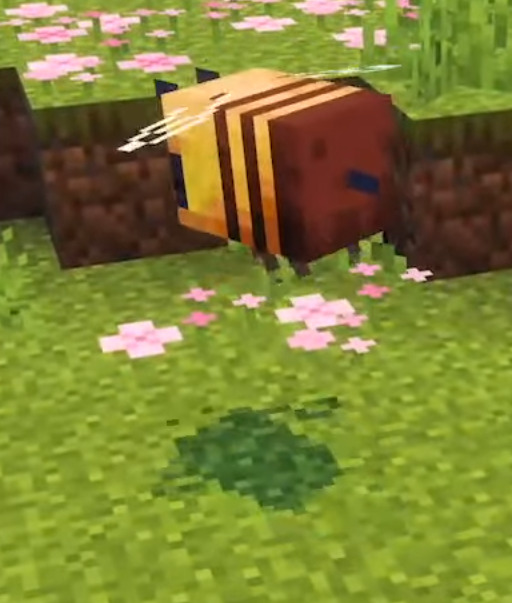
The Dried Ghast is a new block coming in a future update that will generate near nether fossils. It can be taken to the Overworld and rehydrated into a Ghastling, which eventually grows up into a Happy Ghast (the growing process can be sped up by feeding the Ghastling some snowballs!).


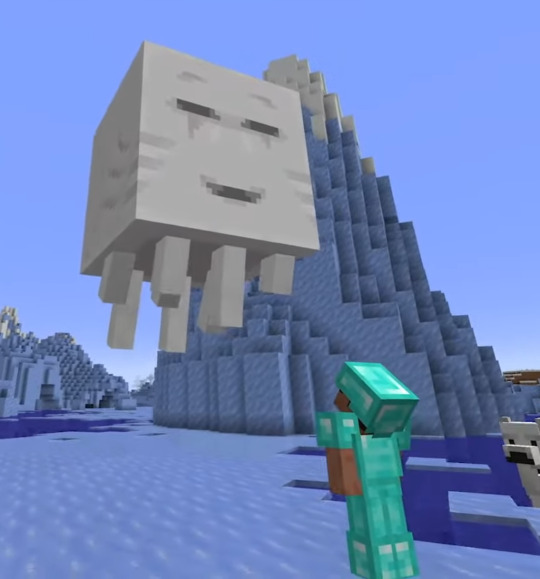
By crafting a Harness (available in all wool colors) and placing it on a Happy Ghast, you and up to 3 other players can fly on it!
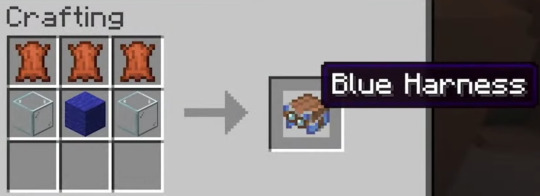

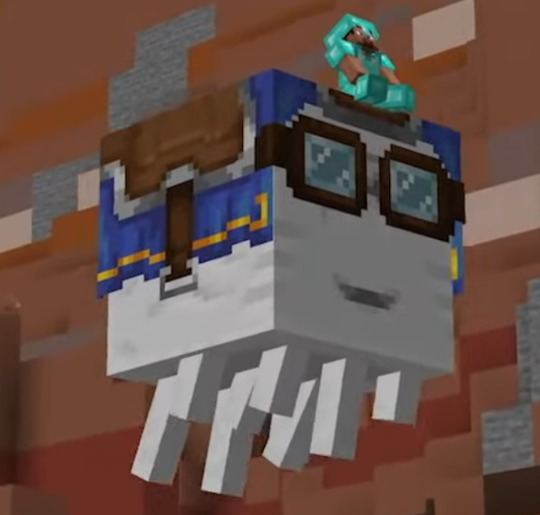
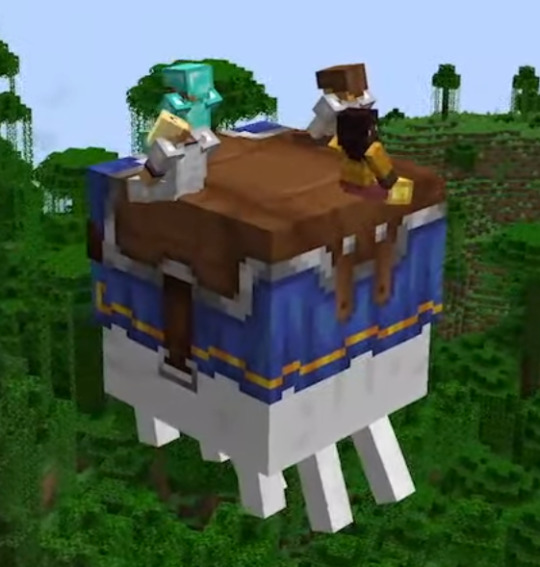
You can even dismount and stand on top of a harnessed Happy Ghast while in midair. The Happy Ghast won't move when someone is standing on it!
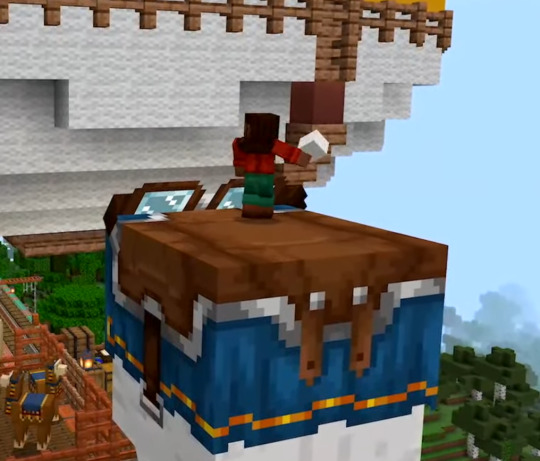
191 notes
·
View notes
Text
TWST Indie Perfume Recs ✦ Scary Monsters
This list features five fragrances per dorm focused around the costumes and backgrounds featured in the first two Halloween events.
Fragrance notes are taken from their respective websites.
Heartslabyul
Buried Alive (Bloodbath) — Patchouli Essential Oil and Graveyard Dirt
Love After Death (Darker Things) — Wilted Roses, Incense, Chocolate Musk, Coffin Wood, Ivy
Knave of Pumpkins (BPAL) — Crushed roses, red currant, and pumpkin tarts.
Pumpkin Tombstone (BPAL) — Dried pumpkin leather with vanilla, balsam and sassafras layered over Virginia cedar.
Midnight in the Graveyard (Paranormal Perfumes) — Cool Rain, Fog, Damp Dirt, Moss, White Funeral Lilies, Dark Patchouli
Savanaclaw
Pirates! (BPAL) — Gunpowder and salt-crusted leather, casks of scorched spices, sweet rum, and a clink of golden amber.
Lorelai (Fantome) — Tart wild strawberries, basil, black narcissus, entangling seaweed, watery graves.
Song of the Siren (Paranormal Perfumes) — Ocean Mist, Coconut Rum, Agave Nectar, Sea Grass, Vanilla, Lime
Old Havana (Solstice Scents) — Tobacco, Woods, Sea Mist, Lime, Spices.
Hook (Storybooke Scents) — Bergamot, Onyx Rose, Sea Moss, Vetiver, Leather, Suede, Spiced Musk
Octavinelle
Stormy Night (Darker Things) — Dark Aquatic Notes, Rain Drenched Earth, Humidity, Wet Pavement, Sodden Foliage and Petals, Storm-Cooled Breeze
Industrial Sabotage (Alkemia) — A cataclysmic wreckage of burnt wires; twisted melted steel; shattered machinery, and gunpowder.
It's Only Magic (CocoaPink) — Lashings of sugary vanilla, magical herbs, dried sage, ritual incense, Bulgarian lavender, musk, and a chilling ocean breeze.
Mad Scientist (Nui Cobalt) — It begins with acid green top notes of Mexican and Persian limes spiked with piquant cardamom. Then a total transformation occurs, revealing blackest vanilla and smooth salted caramel.
Sensory Deprivation Tank (CocoaPink) — Pale liquid vanilla infused with nuances of smoldering tonka bean, calming milk, white oud and wood smoke.
Scarabia
Beast (Storybooke Scents) — Citrus, French Lavender, White Musk, Wood, Leather, Amyris, Patchouli
Harvest Moon (Paranormal Perfumes) — Spiced Bread, Butter, Honey, Anise, Orange Zest, Ginger, Vanilla
Full Moon (Nui Cobalt) — Notes of white tea, steamed jasmine rice, sugared lemon, and cool night air.
Nightwalker (Paintbox Soapworks) — White Patchouli, Oakmoss, Nutmeg, Woodland Herbs
Moonlight, Wolf (BPAL) — Wild patchouli root, fossilized amber, russet musk, clove bud, juniper needles, hay absolute, and earthy oud with a glimmer of yellow crystalline lemon peel.
Pomefiore
Lunar Velvet (Simon's Nest) — Top notes: Fresh fig, creamy coconut and vanilla pod infusion. Heart Notes: Clary sage, black cherry, cassis and lime. Base Notes: Cedarwood, sandalwood, vanilla bourbon and styrax benzoin.
Bloodletting (Bloodbath) — Dark plum, Raspberry, Cranberry, Red Apple, Strawberry, Honey and Rum
Vassago (Fantome) — A silver dagger, red wine mulled with blackberries, cloves, & orange peels, a goblet of blood & a black mirror.
Coven (Paranormal Perfumes) — Black Plum, Peach Nectar, Fallen Leaves, Patchouli, Leather, Peony, Violet, Cinnamon, Vanilla Cashmere
Midnight Merlot (Horror House of Alchemy) — Notes of red grape, strawberry, and cherry with the floral and sweet accents of blossom and vanilla musk
Ignihyde
Mesmer (Fantome) — Deep, luxurious oudh, refined vetiver, cool frankincense, slightly salty ambergris, smooth myrrh, and dark patchouli.
Haunted Harvest (Horror House of Alchemy) — Pumpkin, Lavender, Patchouli, and Egyptian Musk
Ghost Story (Darker Things) — Ghostwood Incense, Black Licorice, Orris, Black Pear, Tonka Bean
Keep Your Head (CocoaPink) — Civilized black tea, Dutch butter cookies and apricots; a circle of protective incense; a glowing grinning pumpkin; and a night wind of whirling leaves, woodsmoke, damp mosses, and tossed earth.
Phantom Team of Horses (BPAL) — A spectral cacophony of shimmering, translucent dun sandalwood, grey amber, and wraith-chilled chestnut galloping through the mist-cloaked shadows of time, a clattering of clove and black pepper, and a crack of phantom leather.
Diasomnia
Blood Moon (Lizabe) — Notes of dragon's blood, incense, patchouli, oranges, cloves, black cherries, cedar, strawberries, pineapple, lime, and tonka bean.
Jubilant Dragon (Wylde Ivy) — Dragon’s Blood incense, dried flower crowns, white patchouli, ylang ylang, and a hint of guaiac wood
Claws (Astrid) — Gunpowder and salt-crusted leather, casks of scorched spices, sweet rum, and a clink of golden amber.
Jeepers Creepers (Nui Cobalt) — Fresh basil, geranium aged 20 years, balm melissa, nutmeg, pink pepper, coriander, tawny musk, and sacred resins of Himalayan cedar, dragon’s blood, labdanum, and opopanax.
When Thy Will Stung the World into Strife (BPAL) — Dragon’s blood resin, red ginger, bourbon geranium, thorny rosemary, red sandalwood, pink pepper, and green coffee bean.
Website Links —
Alkemia
Astrid
Bloodbath
BPAL
CocoaPink
Darker Things
Fantome
Horror House of Alchemy
Lizabe
Nui Cobalt
Paintbox Soapworks
Paranormal Perfumes
Simon's Nest
Solstice Scents
Storybooke Scents
Wylde Ivy
#twst#twisted wonderland#perfume recs#heartslabyul#savanaclaw#octavinelle#scarabia#ignihyde#diasomnia#scary monsters
37 notes
·
View notes
Note
there are three kinds of redwoods and *checks list* a whole bunch of robins, which robins go to which trees?
anon, if you wanted my hand in marriage, you should have just said so. Let's assign each main continuity robin a redwood species based on vibes and life history traits!!!!
Dick Grayson: Giant Sequoia (Sequoiadendron giganteum)
giant sequoia has serotinous cones! serotiny being the term for cones that require fire in order to release their seeds, giant sequoia produce cones containing around a couple hundred seeds per cone and over A THOUSAND cones per tree!!! these cones can remain green and closed for up to 20 years without fire to dry them out, allowing them to release their seeds!! Fire serves another purpose, namely getting rid of competing species. Giant Sequoia is extremely shade intolerant, so if there are a lot of other trees providing shade, they're not going to do great. However, while fire has its benefits, too strong wildfires can spread into the tree crowns and incinerate both foliage and cones, killing the tree and preventing restoration.
Dick reads as giant sequoia for its shade intolerance and his tendency towards performance!! he doesn't know what to do with himself when he's not in a spotlight. Additionally, his tendency towards risk is found in the giant sequoia relationship with fire: the benefits of fire are more significant to the giant sequoia than its negatives, and it has several adaptations such as thick bark near its base and a tendency for foliage to grow far, far off the ground that make it fire resistant!! Lack of fire actually tends to be more harmful for giant sequoia than not. that being said, a risk is still a risk, and while Dick thrives in vigilantism, it has definitely had its drawbacks.
Jason Todd: Dawn Redwood (Metasequoia glyptostroboides)
this is where i confess that most of my research has been into giant sequoia so far, and a little bit into coast redwoods, and ive really only glanced over stuff about dawn sequoia because there's enough information to write a 180 page paper solely on giant sequoia reproductive ecology and. well! like. so all this research is purely for hobby purposes so.
so i chose Dawn Redwood for Jason because of its history: dawn redwood is fun because it's a fossil species, like the coelacanth!! It was first discovered through fossils before living specimens in china were identified as those same trees, around world war 2. dawn redwood is classified as an endangered species, but is grown in a lot of places, especially as a decoration!!!
I'm sure you can see where I'm going with this one. Jason, who spent a significant amount of time haunting the narrative before being discovered to be alive and the dawn redwood who occurred in fossil records before being identified alive? I like it :DDD
Tim Drake: Giant Sequoia (Sequoiadendron giganteum)
first, he's giant sequoia because that's what dick grayson is and he wants to be like dick grayson.
second, let's talk more about giant sequoia seed production because that's what i know about and so that's what i'm basing a lot of this on, okay? So, giant sequoia trees produce over a thousand (~1500 average) cones per tree, with ~200 seeds each, so a mature sequoia will produce ~300,000 seeds, and those 300,000 seed will be released when heat from a fire at the base of a tree dries that cone and allows it to open. Most of those seeds will die within the first two years. ~98.6% of them, actually.
This is about Tim's relationship with Robin to me!! First, he becomes Robin as the result of tragedy, with the deaths of Jason and then his mother, as the 300,000 seeds are released after a fire. 300,000 seeds released with the hope for germination, growth, and possibly becoming one of those great and wonderful trees, Tim is initially hopeful for what he will be able to do, so many people around him die, over and over and over again
oh and this is also another point for giant sequoia as the dick grayson species as well!!
Stephanie Brown: Coast Redwood (Sequoia sempervirens)
ok s the fic in question that im doing all this research for is a stephanie brown centric fic and so i have actually been thinking about all of these trees in relation to her already and she is all of them because she is my special girl. HOWEVER she is coast redwood!!!
so, coast redwood, while being fire resistant is not serotinous like the giant sequoia!! it typically grows taller than giant sequoia do as well: the tallest known tree in the world is a coast redwood named Hyperion!!! Coast Redwoods are prized for their lumber: it's spectacularly decay resistant!! also unlike the giant sequoia, coast redwood are very shade tolerant. Additionally, while they do produce seed bearing cones, coast redwoods can reproduce through sprouting, sending shoots up from cut and/or felled stumps. Disruption that kills shoots often ends up with more shoots being sent up than before.
Coast Redwood I chose for Stephanie because of their shared resilience. Stephanie is disrespected and overshadowed, she endures hardship, but she endures, thrives, grows tall, becomes Batgirl, and makes the mantle her own. Like the heartwood of this species, stephanie's heart too is decay resistant
Damian Wayne: Dawn Redwood (Metasequoia glyptostroboides)
For similar reasons as Jason: took a while longer than the others before it was discovered, BUT let's get a little more into the history! I mentioned that it's considered an endangered species but is grown in a wide variety of places for decoration. When live specimens were identified, seeds were collected and sent internationally to the US and Europe where they were able to be grown and studied. For Damian, I chose the Dawn Redwood because he too, was transplanted across countries. Also, it's significantly shorter than the other redwoods (giant sequoia and coast redwood can get ~300-400 feet tall, while dawn redwood grows to around 150 feet) and he's the youngest!!!
Duke Thomas: Coast Redwood (Sequoia sempervirens)
Like Stephanie, coast redwood has been chosen for Duke because of shared resilience!!! Additionally. And this I found out as I was double checking something as I was making this post. So, one feature of coast redwoods is that sometimes they form basal cavities. There's a pretty famous redwood attraction known as Shrine Tree, which you might already know: it's the one that you can drive your car through. That hole is what's known as a basal cavity, where when a coast redwood is damaged (usually from lightning/fire) the wood can rot through. While there are other redwood tree attractions you can drive a car through, shrine tree is the only one naturally formed. The thing about basal cavities. is that. they make a great home for bats. yeah. so. i know what im going to be looking into later. But I bring this up because!! since these coast redwoods are able to provide a home for bats as a result of hardship, it speaks to duke's community building tendencies for me!! his parents were jokerized, he has to endure hardship, he endures and thrives and builds and directs his community as a direct effect of that hardship!!! Like the shelter the basal cavity provides after disaster, Duke finds friendship and community through his struggles.
35 notes
·
View notes
Text
Fossil Friday: Eremotherium

Eremotherium, the Wandering Ground Sloth or Pan-American Ground Sloth, lived in southern North America, Central America and northern South America from the Pliocene Epoch about 5 Ma to possibly the early Holocene Epoch (the current epoch we are in).

It was discovered in Skidway, Georgia in 1823 by fossil collectors J.P. Scriven ad Joseph C. Habersham, described by Joseph Leidy in 1855, and mistaken for Megatherium until 1948 when Franz Spillmann recognized it for a new genus and named it Eremotherium.

Because the rocks it is found in are so young, it was very difficult to find any information on formations. A lot are just unconsolidated sediments that haven't been buried long enough to be properly turned into rock yet. Wild to think about. Old enough to fossilize bone but not old enough to make a rock. One of the biggest localities for finding Eremotherium is in Florida in a karst site (limestone that has undergone dissolution producing a rugged landscape of sinkholes, ridges, and fissures) filled with unconsolidated clay where an old Pleistocene lake used to be.

Eremotherium lived alongside very familiar animals like Trachemy platymarginata, a pond turtle,
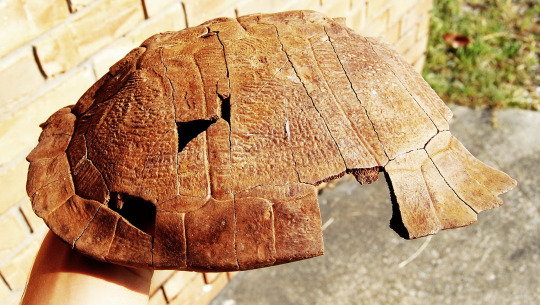
Holmesina floridanus, a giant armadillo,
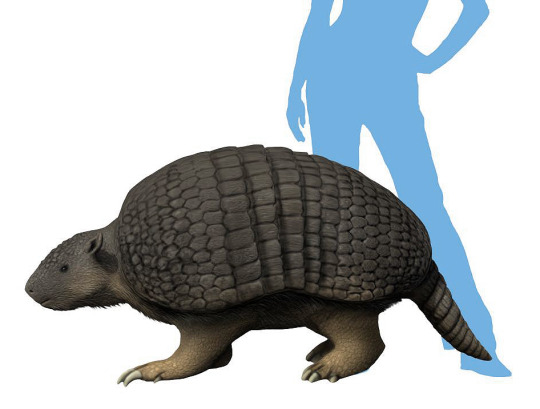
Tapirus lundeliusi, a tapir,

Chelydra, a snapping turtle,

Erethizon poyeri, a porcupine,

and Amplibuteo concordus, an eagle,

as well as many other animals including an alligator species in Florida. In Brazil, it was living with more unfamiliar animals such as Toxodon platensis,
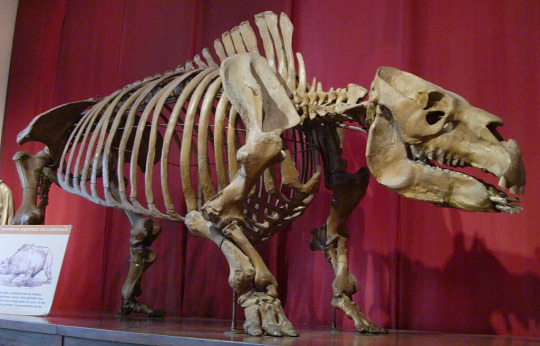
Glytotherium,

Panochthus,

as well as a few armadillos.

Eremotherium is part of the class Mammalia, the clade Eutheria, the superorder Xenarthra, the order Pliosa, the clade Megatheria, the family Megatheriidae and the subfamily Megatheriinae. There are two species of Eremotherium, E. eomigrans and E. laurillardi.

It's closest living relative is the Three-toed Sloth.

Eremotherium was 20 ft (6m) long, about 6.6 ft (2m) tall on all fours and 13 ft (4m) tall when rearing. The most recent estimates have it weighing in at 6, 931 lbs. (3,144 kg).

It's skull measured 25.6 in (65cm) in length and was close to 13 in (33cm) wide at the zygomatic arches (bones that go from the temples, around the eye socket toward the upper jaw bone). It had a shortened nasal bone (nose) giving it a sort of truncated cone appearance and it had small, shallow eye sockets that sat slightly lower than its relatives. The teeth of Eremotherium are large, rectangular when viewed occlusally, and have a unique v-shaped valley in lateral view. Both species had 5 upper and 4 lower teeth in each side of the jaw, with upper and lower crowns interlocking along the V-shaped valleys into what was likely a shearing surface for processing leaves and small branches

The vertebrae were massively built but also compressed anterior-posteriorly giving it a shortened look overall especially in the tail.


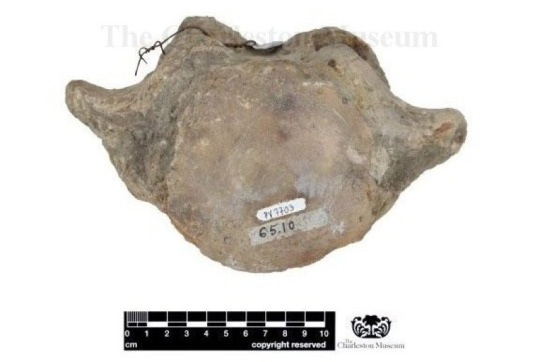
They have very robust limb bones to carry their immense weight. look at these beefy bones!

The two species had a different number of digits on their hands with E. eomigrans having five digits and E. laurillardi having only three.


Eremotherium primarily moved on all fours with its feet turned inward, its weight resting on the outer phalanges. This all suggests it was pretty slow. Shocker, a slow sloth? Who would have guessed? It's hands were not properly shaped for digging as once thought due to its large claws but the fingers had limited mobility that would have made this endeavor impossible. However, it was able to rear on its hind legs and pull branches down with its hands. This, along with its teeth and the animals it lived alongside suggests it lived in mixed woodland forests and ate a wide variety of foliage.

There have been a number of sites with multiple individuals that have led to debates about whether they lived in family groups or not. Modern sloths are solitary but that doesn't necessarily rule out group living. Some scientists think that the bone beds were filled with individuals who died at different times in the same place, others think they died at the same time and lived in herds. It's hard to say.

Thanks for tuning this week! I hope you all have a wonderful weekend and make sure to tune in Monday to learn more about large igneous provinces. Fossilize you later!

#paleontology#fossils#fun facts#science#science education#prehistoric mammals#ground sloth#florida#brasil#georgia#earth science#science side of tumblr
15 notes
·
View notes
Text

Behold!!! Im doing funguary this year (or trying to)
This is for day 1: mycena subcyanocephala!
This creature is a slugcat named the Tiny (she/her). She's about the size of a two-month-old kitten but is fully grown. Tiny lives in the Glowing Fields, a dark subregion below FOSSIL's can. Tiny's glowing frills and small size help her stay camouflaged amongst the bioluminescent foliage of her home :]
#raintailed's art#rain world#rw#funguary#funguary2024#rain world oc#my ocs#the tiny (oc)#reference#so small....
97 notes
·
View notes
Text
Crystal Palace Field Trip Part 1: Walking With Victorian Monsters
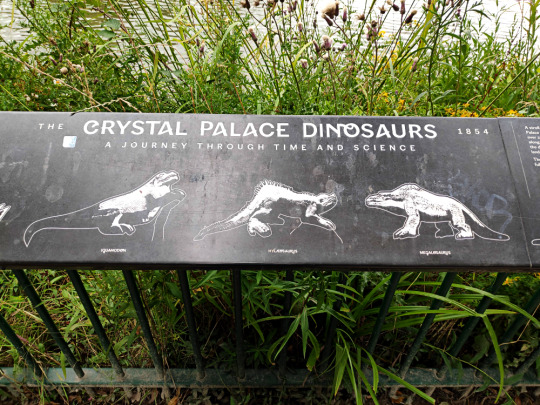
The Crystal Palace Dinosaurs take their name from the original Crystal Palace, a glass-paned exhibition building originally constructed for a World's Fair in Hyde Park in 1851.
In 1854 the structure was relocated 14km (~9 miles) south to the newly-created Crystal Palace Park, and a collection of over 30 life-sized statues of prehistoric animals were commissioned to accompany the reopening – creating a sort of Victorian dinosaur theme park – sculpted by Benjamin Waterhouse Hawkins with consultation from paleontologist Sir Richard Owen.
The Palace building itself burned down completely in 1936, and today only the ruins of its terraces remain in the northeast of the park grounds.

The Crystal Palace building then and now Left image circa 1854 (public domain) Right image circa 2011 by Mark Ahsmann (CC BY-SA 3.0)
Six sphinx statues based on the Great Sphinx of Tanis also survive up among the Palace ruins, flanking some of the terrace staircases. They fell into serious disrepair during the latter half of the 20th century, but in 2017 they all finally got some much-needed preservation work, repairing them and restoring their original Victorian red paint jobs.

———
…But let's get to what we're really here for. Dinosaurs! (…And assorted other prehistoric beasties!)
The "Dinosaur Court" down in the south end of the park still remains to this day, displayed across several islands in a man-made lake. Over the decades they've been through multiple cycles of neglect and renovation, and are currently cared for by the London Borough of Bromley (Crystal Palace Park Trust are due to take over custodial duties in September 2023), with promotion and fundraising assistance from organizations like Historic England and the Friends of the Crystal Palace Dinosaurs charity.
Just about 170 years old now, the Crystal Palace Dinosaurs represent fifteen different types of fossil creatures known to 1850s Victorian science, with only three actual dinosaur species featured. Although often derided for being outdated and very inaccurate by modern standards, they were actually incredibly good efforts at the time, especially taking into account that the field of paleontology was still in its very early days.
They also just have a lot of charm, with toothy grins and surprisingly dynamic poses.
Unfortunately on the day I visited in early August 2023 most of the statues were heavily obscured by plant growth, both on their islands and on the sides of the paths they can usually be viewed from. Since I'd seen images from about a month ago showing things being less overgrown, this was probably just some unlucky timing on my part coinciding with some explosive summer foliage growth.
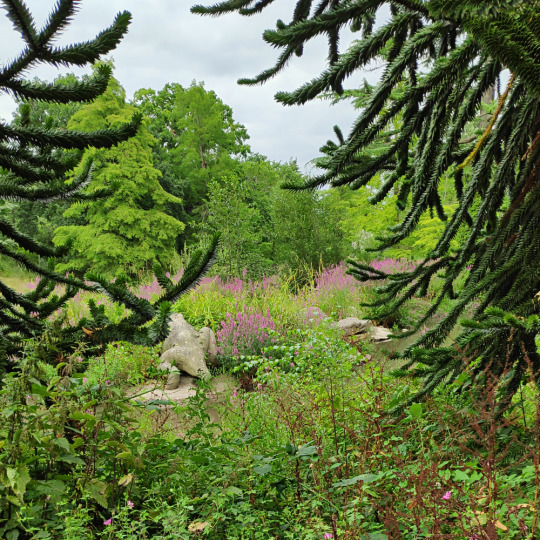
The first island on the trail features a few Permian and Triassic animals which were only known from fragmentary remains in the 1850s. These "labyrinthodonts" were recognized as having similarities to both amphibians and reptiles, and so were depicted with boxy toothy jaws, warty skin, stumpy tails, and long frog-like back legs.
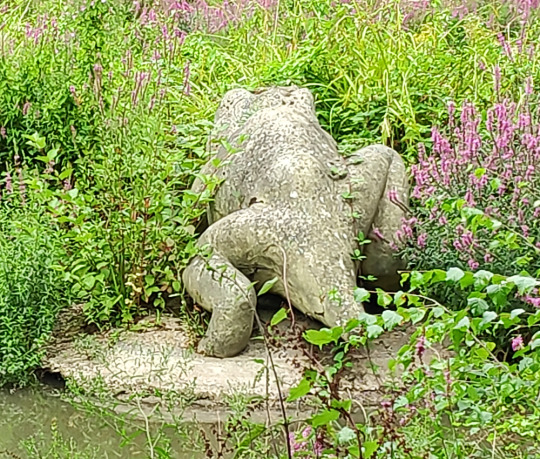
Today we'd call these particular animals temnospondyl amphibians, specifically Mastodonsaurus, and we know they were actually shaped more like giant salamanders with longer flatter crocodilian-like jaws, smaller legs, and long paddle-like tails.

———

Somewhere in the foliage beyond this specific "labyrinthodont" there was also supposed to be a pair of dicynodonts, but I couldn't see much of them at all and didn't manage to get a remotely visible photograph.
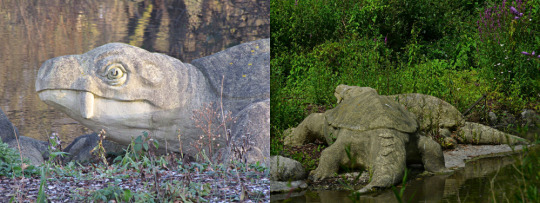
Crystal Palace Dicynodon when much less overgrown Left photo by London looks (CC BY 2.0) Right photo by Loz Pycock (CC BY SA 2.0)
These Dicynodon are depicted as looking like sabre-toothed turtles complete with shells. That was fairly speculative even for the time, but considering only their weird turtle-beaked-and-walrus-tusked skulls were known it was probably the best guess Hawkins and Owen had. Today we know these animals were actually synapsids related to modern mammals, but Victorian understanding considered them to be a type of reptile.
Modern reconstructions of dicynodonts have a slightly different face shape, along with squat pig-like bodies and semi-sprawling limbs. They may have had fur, but currently the only known actual skin impressions from the genus Lystrosaurus show leathery bumpy hairless skin.

———
Next time: the Jurassic and Cretaceous sculptures!
#field trip!#crystal palace dinosaurs#retrosaurs#i love them your honor#crystal palace park#crystal palace#labyrinthodont#temnospondyl#mastodonsaurus#dicynodont#dicynodon#synapsid#paleontology#vintage paleoart#art
387 notes
·
View notes
Note
Oh very fun idea what is the life cycle of an isabeau like
Isabeaus follow a typical Change life cycle. As mentioned in the Siffrin life cycle post, a Change-based life cycle is similar to that of a metamorphosis. For those interested, I’ll likely make a post about Change Cycles in Isatlings later as it’s a really fascinating phenomenon, especially with how similarly it replicates actual Body Craft in people!
Back to Isabeaus- an Isabeau has 4 stages. Egg, Childhood, the “Change Period” (also often referred to as “Cocoon Time” by casual caretakers), and Adulthood. The cycle is similar to that of the complete (holometaboly) metamorphosis observed primarily in insects, as it follows many similar conditions.
more below the cut, bc I’ve found these posts get pretty long!
Egg Stage
Despite their later size, an Isabeau egg is relatively small. It is easily mistaken as the egg of a Vaugardian Quail, being decorated with splotchy Change symbols. It has a hard shell, as is common place for Rock Craft species. While breaking out of the shell is no issue for an Isabeau, it will remain within its broken shell for some time as it acclimates to its new environment. It is best to leave an Isabeau alone for around 5 hours after hatching to let it warm up to its new surroundings, and to let it work up an appetite that will make it more likely to approach any introduced foods.
Childhood Stage
This stage of an Isabeau is incredibly shy and standoffish at first, and will strongly resist socialization attempts. Child Isabeaus need constant mental stimulation, as well as many places to hide. It’s encouraged to be actively engaging with your Isabeau during this time in order to build trust. An Isabeau that trusts you will leave its hiding place without resistance, and may seek you out for comfort instead (highly recommend that you wear something with pockets or a hood while handling a child Isabeau so they have somewhere to curl up in).
“Change Period”
This stage is often the most stressful stage for caretakers, and for the Isabeau itself. It requires a lot of effort for an Isabeau to Change, and many caretakers may not be equipped to provide the best environment for their Isabeau.
Before this period begins, an Isabeau will start to eat less, often storing much of its food in a specific location, until it eventually will refuse food altogether. It will also begin to build a sort of nest for itself in the darkest and most private area of its enclosure. This space is filled with comfortable objects and food for the Isabeau, and is made to be as closed off and quaint as possible.
Should an Isabeau not have proper hiding spaces, it will delay its Change until a space is provided or it manages to create one (typically out of bedding or leaves). While not immediately fatal, it is greatly discouraged to let your Isabeau delay its Change, as it heightens its stress during an already physically taxing time period. Cardboard boxes, fish houses, large pipes, oversized foliage, etc are all options so long as they can be completely closed off and effectively hide the Isabeau.

pictured: an isabeau preparing a space for its Change. this is of my own isabeau, actually! it took around 3 days until he was done “decorating”.
Once the space is properly prepared, the Isabeau will remain inside it for many months. During this time, it is creating a cocoon for itself, starting from the feet and eventually closing over the head, set in a fetal position. Within the cocoon, the Isabeau is re-shaping itself, and will double in size. Once it’s done, the Isabeau will break out of its cocoon from the posterior side of its body, emerging as an adult Isabeau.
The cocoon itself will remain, should your Isabeau not attempt to break or eat it before you grab it. At first, the cocoon will be soft and oily, until it eventually hardens enough to break rocks with. (This is no exaggeration: I have one. It can and has cracked open fossils.)
Adulthood
Adulthood! An Isabeau at this stage is done physically growing, and can be easily socialized to other Isatlings. During this stage, an Isabeau will begin to change things about its environment, and experiment a lot with its appearance and clothing style.
#isathusbandry#isat husbandry#isat#some hiding spaces get incredibly elaborate!!!#I’ve seen some that are MASSIVE!! what’s an Isabeau need a 3 story space for?? ambiance maybe??#isabeau isat
48 notes
·
View notes
Text
a list of "beautiful" words for january
to try to include in your next poem/story
Accollé - in heraldry: entwined about the neck; also: collared, gorged
Bacciferous - bearing berries
Commorient - one of two or a number of persons perishing at the same time by the same calamity
Dreikanter - a three-faced pebble faceted by wind-blown sand
Estaminet - a small café
Frondescence - the condition or period of unfolding of leaves; foliage
Graveolent - having a rank smell
Hwyl - fervor, excitement
Ichnite - a fossil footprint
Jardiniere - an ornamental stand for plants or flowers
Knop - a usually ornamental knob
Lacustrine - of, relating to, formed in, living in, or growing in lakes
Mucedinous - having the nature of or resembling mold or mildew
Nomistic - based on or conforming to moral law
Oblivescence - an act or the process of forgetting
Pabulum - intellectual sustenance
Quodlibet - a whimsical combination of familiar melodies or texts
Risorgimento - a time of renewal or renaissance; revival
Saeculum - a period of long duration
Trouvaille - a lucky find
More: Lists of Beautiful Words ⚜ Word Lists ⚜ Writing Resources PDFs
#beautiful words#writeblr#dark academia#january#writing prompts#spilled ink#linguistics#langblr#studyblr#writers on tumblr#writing prompt#poetry#poets on tumblr#literature#lit#word list#creative writing#fiction#writing reference#light academia#writing resources
339 notes
·
View notes
Note
HERE'S HALF OF WHAT I CAN OFFER (Text limit hates me)
The Iguanodon was first discovered as a set of teeth that clued into a giant herbivore. It was found by Mary Ann Mantell and her husband Dr Gideon Algernon Mantell in 1822. They were believed to be horned for 28 years before it was revealed that the supposed horn was actually a thumb. While we don't fully know what it's thumbs were used for, it's believed they were for separating foliage from branches or opening seeds!! The Concavenator (meaning "Cuenca hunter"), is a genus of carnivorous carcharodontosaurian from the early Cretaceous, discovered in 2010 by paleontogists Fernando Escaso, José Luis Sanz, and Francisco Ortega in the Las Hoyas fossil site in Spain. With only a single species to go off of, Concavenator grew up 6 meters (20 ft) in length and 400 kg (880 lbs) in weight. The main feature that distinguished it from other carcharodontosaurians is the way its neural spines of last dorsal vertebrae created a sail. Not much is known about this genus and we haven't found many fossils, which makes gathering information on it difficult! The Herrerasaurus (meaning "Herrera's Lizard"), is a genus of carnivorous saurischian from the Late Triassic, discovered in 1958 by rancher Victorino Herrera in Argentina. It's classification was heavily debated up until 1988 when a near complete skull and skeleton were found and used to end the debate on saurischian. The largest known specimens grew up to 6 meters (20 ft) in length, 350 kg (770 lbs) in weight, and had a skull up to 56cm (22 inches) in length. Herrerasaurus was bipedal and assumedly a fast runner based on its short thighs and long feet, each of which held 5 toes, three in the center holding weight and the outer 2 being small, the first of which held a sharpened claw. It's tail functioned as a speed and balance adaptation, being semi-stiffened by overlapping vertebrae!! The Lambeosaurus (meaning "Lambe's Lizard"), is a genus of herbivorous hadrossaur from the Late Cretaceous, discovered in 1914 by several unnamed paleontologists in Canada, and named by William A. Parks to honor Lawrence M. Lambe's contribution to the creation of the stephanosaurus genus.
Darling, darling, breathe. You'll pass out if you keep talking. Not that I'm protesting. I must say, that Herrarasaurus reminds me of someone...
8 notes
·
View notes
Text
Round 3 - Reptilia - Musophagiformes




(Sources - 1, 2, 3, 4)
Our next order of birds, and our last in the Otidimorphae clade, is the Musophagiformes, commonly called “turacos” or “loeries”. They contain one living family, Musophagidae, and 5 genera.
Turacos are medium-sized arboreal birds endemic to sub-Saharan Africa, where they live in forests, woodland and savanna. They often have prominent crests and long tails, and are noted for peculiar and unique pigments (see propaganda below) giving them their bright green and red feathers. Turacos are semi-zygodactylous: their fourth (outer) toe can be switched to point either forward or backward. The second and third toes, which always point forward, are conjoined in some species. Turacos are non-migratory, weak fliers, but they are strong climbers and are able to move nimbly on branches and through vegetation. Juveniles are born with claws on their wings to help them climb. They are herbivorous, eating fruit, flowers, and leaves.
Turacos are social, living in family groups of up to 10 individuals. They build large stick nests in trees, into which they lay 2 or 3 eggs. Both sexes incubate the eggs. Turaco chicks are born with thick down and open, or nearly-open, eyes, and the aforementioned wing claws.
Musophagiformes are part of the clade Otidimorphae, which also includes the Otidiformes (bustards) and Cuculiformes (cuckoos). Otidimorphs arose in the Eocene, around 34 million years ago. The oldest Musophagiform fossil is Foro panarium, from the Early Eocene. Modern turacos evolved in the Oligocene, around 24 million years ago.
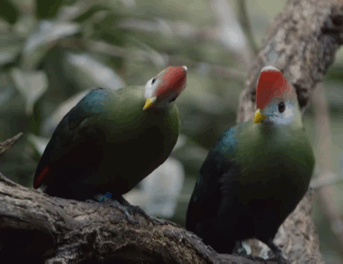
(source)
Propaganda under the cut:
Turacos are noted for their unique pigments. Turacin is a naturally occurring red pigment found only in turacos. Other birds derive their red coloration from carotenoids (creating bright and orange-reds) or phaeomelanins (creating rusty and brownish-reds). Turacoverdin is a unique copper uroporphyrin pigment responsible for the bright green coloration of some turaco species. Turacoverdin is the only true green pigment found in birds! The coloration that appears in green feathers on other birds is due to the unique properties of blue structural coloration combined with yellow carotenoids. Turacin and turacoverdin are both copper-based pigments, and thus require large quantities of copper in order to be manufactured. Turacos are able to accumulate copper through a diet rich in fruits, flowers, buds, and other plant matter. It can take up to 3 months of fruit intake to accumulate enough copper to grow new pigmented plumage. It takes young turacos around a year to acquire their colorful adult plumage. Turaco species inhabiting forests are more likely to be green in color, using their green feathers to camouflage in dense foliage.
The largest turaco is the Great Blue Turaco (Corythaeola cristata) (image 4), which can be 70–76 cm (2.3-2.5 ft) long and weigh 800–1,231 g (1.8–2.7 lb).
In the Democratic Republic of the Congo, the Great Blue Turaco is associated with the Okapi (Okapia johnstoni), who it warns of danger by calling loudly.
Many species of turaco are quite noisy, with the Go-away-birds (genus Crinifer) (image 3) being especially noted for their piercing alarm calls, which alert other animals to the presence of predators.
The crimson flight feathers of some turaco species are important in the ceremonial regalia of the Swazi royal family of Eswatini.
The Purple-crested Turaco (Gallirex porphyreolophus) is an important seed disperser for cycads. They are known to eat the fruits of cycads and fly long distances between feeding and nesting sites, regurgitating the seeds intact where they can germinate far from the parent plant.
64 notes
·
View notes